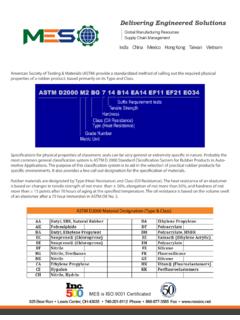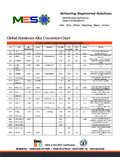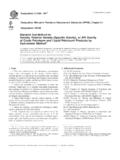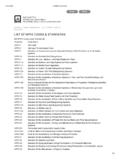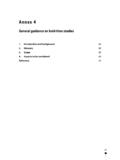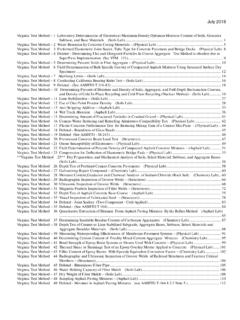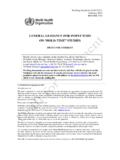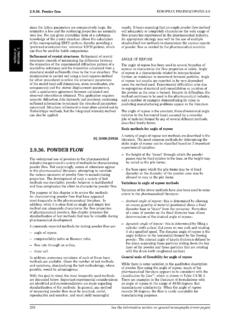Transcription of Delivering Engineered Solutions - MES, Inc.
1 Delivering Engineered Solutions Global Manufacturing Resources Supply Chain Management India China Mexico Hong Kong Taiwan Vietnam American Society of Testing & Materials (ASTM) provide a standardized method of calling out the required physical properties of a rubber product, based primarily on its Type and Class. Specifications for physical properties of elasomeric seals can be very general or extremely specific in nature. Probably the most common general classification system is ASTM D 2000 Standard Classification System for Rubber Products in Auto- motive Applications. The purpose of this classification system is to aid in the selection of practical rubber products for specific environments.
2 It also provides a line call out designation for the specification of materials. Rubber materials are designated by Type (Heat Resistance) and Class (Oil Resistance). The heat resistance of an elastomer is based on changes in tensile strength of not more than 30%, elongation of not more than 50%, and hardness of not more than 15 points after 70 hours of aging at the specified temperature. The oil resistance is based on the volume swell of an elastomer after a 70 hour immersion in ASTM Oil No. 3. ASTM D2000 Material Designation (Type & Class). MES is ISO:9001 Certificated 625 Bear Run Lewis Center, OH 43035 740-201-8112 Phone 866-877-3585 Fax ASTM D2000 Suffix Letter and Numbers Suffix Requirement tests These indicate the additional testing requirements needed to satisfy this specification callout.
3 Each requirement is com- prised of a suffix letter, calling out the property being tested, and the suffix numbers, which call out the the test method and test temperature. Z (if added at the end) suffix tests denote a customer added or specific test that is not necessarily covered by the D2000 document. M. If the M is present, the unit of measure is expressed in Metric units. If the letter M is not present however, the unit of measure is in English units (as in psi for the tensile strength). Prior to 1980, all ASTM specifications were in English units. Beginning in 1980, the Metric unit callouts became the standard. Grade Number The Grade Number designates instances where more extensive tests are required.
4 Any grade other than 1 mandates additional requirements that are spelled out in Table 6 of the D2000 document. Type Indicates the Heat Resistance properties of the elastomer. A 70C 158F. B 100C 212F. C 125C 257F. D 150C 302F. E 175C 347F. F 200C 392F. G 225C 437F. MES is ISO:9001 Certificated 625 Bear Run Lewis Center, OH 43035 740-201-8112 Phone 866-877-3585 Fax H 250C 482F. J 275C 527F. Class Indicates the Oil Resistance properties of the elastomer as measured by volume swell under test procedures Volume Swell, Max. %. A No Requirement B 140. C 120. D 100. E 80. F 60. G 40. H 30. J 20. K 10. Hardness The Shore A Durometer hardness requirement of the elastomer.
5 In this case the 7 calls out 70 +/- 5 Durometer. Tensile Strength This indicates the minimum tensile strength of the elastomer. If the designation has an M after the Revision Year, then this callout is stated in Metric units, megapascals (MPa). If no M is present, then the callout is specifying the English unit, pounds-per-square inch (psi). In this example, the 14 is calling-out 14 MPa. The conversion to psi is: MPa x 145 = psi. Therefore, the psi Tensile Strength requirement of this designation is 14 x 145 = 2030 psi. Tensile strength is the maximum tensile stress reached in stretching a test piece (either an O-ring or dumbbell). Tensile tests are used for controlling product quality and for determining the effect of chemical or thermal exposure or an elastomer.
6 In the latter case, it is the retention of these physical properties, rather than the absolute values of the tensile stress, elongation or modulus, that is significant. Elongation: The strain, or ultimate elongation, is the amount of stretch at the moment of break. Modulus: Also called "Mod 100" This is the stress required to produce a given elongation. In the case of "Mod 100", the modulus would be the stress required to elongate the sample 100%. In elastomers, the stress is not linear with strain. Therefore the modulus is neither a ratio nor a constant slope, but rather denotes a point on the stress-strain curve. Test Methods: ISO 37. ASTM D412. Elastomers are often treated as incompressible materials for analytical convience.
7 However, in many instances the com- pressive response of elastomers is very important. bulk or Static Modulus. The bulk modulus is a property of a material which defines its resistance to volume change when compressed. It can be expressed as: MES is ISO:9001 Certificated 625 Bear Run Lewis Center, OH 43035 740-201-8112 Phone 866-877-3585 Fax K = p/ev Here p is the hydrostatic pressure, ev is the volumetric strain and K is the bulk modulus. In practice, a positive volumetric strain is defined as a decrease in volume. Measuring a material's strain response to an applied pressure is a simple test for bulk modulus. The bulk modulus can be expressed as the derivative (slope) of the pressure-strain curve.
8 Relationships between Young's modulus E, the shear modulus G, and Poisson's ratio v are related by: E = 3 K (1 - 2v). E = 2 G (1 + v). Test Methods: ISO 7743. ASTM D575. Rebound Resilience. When a pendulum hammer impacts a rubber specimen from a certain distance or angle, the degree or distance that the pendulum does not return is an indication of the energy lost during the deformation. Test Methods: ISO 4662. ASTM D1054, D2632. Compression Set: Elastomer compression set is a measurement of the ratio of elastic to viscous components of an elastomer's response to a given deformation. Longer polymer chains tend to give better "set resistance" because of the improved ability to store energy (elasticity).
9 Elastomer compression set measurement standards call for a 25% compression for a given time and temperature. The cross-section is measured after the load is removed. Elastomer compression set is the percentage of the original compres- sion (25%) that is not recovered. This test may be conducted on cylindrical disks or O-rings. At the end of the test, the samples are removed and allowed to cool at room temperature for 30 minutes before measuring. After a load is released from an elastomer, the difference between the final dimensions and the original dimensions is considered the compres- sion set. The use of elastomer compression set measurements is most beneficial for production quality control, indicating the degree of curing.
10 Elastomers with high compression set values may require special considerations for gland design and handling. Elastomer compression set is a relatively simple test to perform, and as such, may not yield the type of predic- tive information desired for custom sealing applications. When a constant load is placed on an elastomer, the deformation is not constant, but rather it increases gradually with time. Terms used to describe this behavior are relaxation or creep. These properties, including compression set, are a result of physical (viscoelastic) and chemical (molecular structure) changes in an elastomer. Test Methods: ISO 815 (Ambient & High Temp.). ISO 1653 (Low Temp.)
